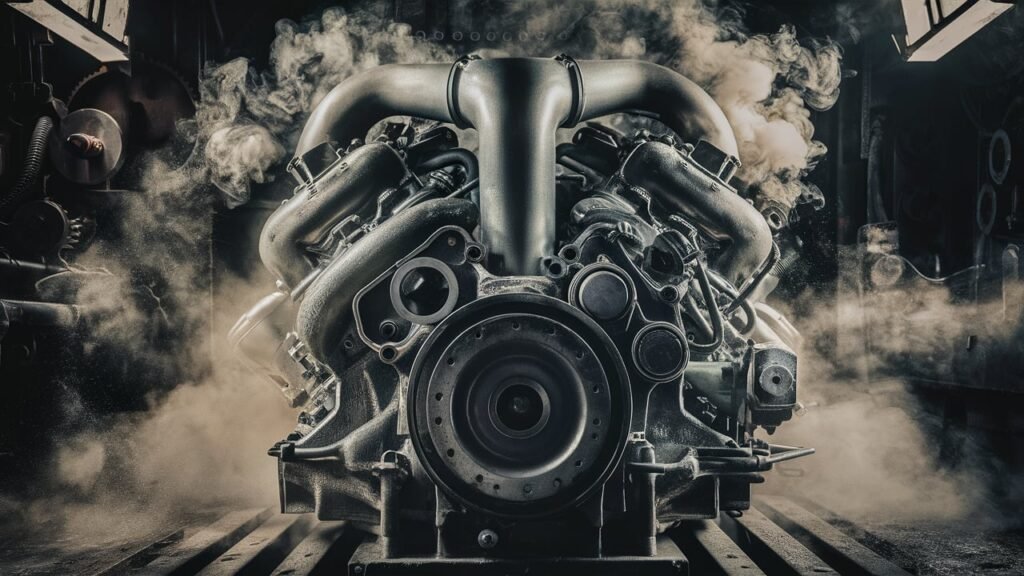
Unveiling the Mechanics of a Car Engine Brake Rotor
In the intricate dance of automotive engineering, one component reigns supreme in the realm of stopping power: the car engine brake rotor. As a crucial element within the braking system, the brake rotor serves as a silent hero tasked with transforming kinetic energy into thermal energy through friction.
Such a pivotal role demands precision and durability, qualities that automotive enthusiasts, mechanics, engineering students, and car owners alike appreciate and seek to understand on a deeper technical level.
For those enthralled by the symphony of mechanical movements beneath a vehicle’s chassis or those whose hands deftly navigate the inner workings of an automobile, unraveling the mysteries surrounding the car engine brake rotor unveils a world where function meets finesse.
An exploration into the heart of this vital component reveals not just its physical manifestation but also its collaborative efforts with companions like brake pads and calipers.
Delving further allows us to dissect the types of brake rotors gracing different vehicles, shedding light on how each variant resonates uniquely with performance considerations and design nuances—a domain where innovation intertwines with tradition to redefine braking excellence.
Join us on this odyssey into precision engineering and dive deep into unravelling the mechanics that underpin every road-worthy journey.
Understanding Car Engine Brake Rotor
A brake rotor, also known as a brake disc, is a crucial component in a vehicle’s braking system. Its primary function is to work in conjunction with other parts such as brake pads and calipers to slow or stop the rotation of the wheels when necessary.
When the driver applies pressure to the brake pedal, hydraulic pressure forces the brake pads against the rotating surface of the brake rotor, creating friction that converts kinetic energy into heat energy, slowing down the vehicle.
The interaction between the brake rotor, brake pads, and calipers is vital for effective braking performance. As the brake pads squeeze against both sides of the spinning rotor under pressure, friction is generated, converting motion into heat.

This process causes wear on both the brake pads and rotors over time. Different types of vehicles utilize various kinds of brake rotors based on factors such as weight distribution, driving conditions, and performance requirements.
For instance, heavy-duty trucks may use larger or thicker rotors compared to compact cars due to their increased mass and stopping power needs.
There are several types of brake rotors commonly used in vehicles today. Solid rotors are more traditional and provide consistent braking performance suitable for everyday driving scenarios.
On the other hand, ventilated or slotted rotors feature special designs that aid in heat dissipation during heavy braking applications or high-speed driving. These variations in design cater to different driving styles and environmental conditions to ensure optimal braking efficiency and safety on various road surfaces.
Components of a Car Engine Brake Rotor.
A car engine brake rotor comprises various critical components that work together to facilitate effective braking performance. The key parts include the brake discs, vanes, and cooling fins.
The brake discs, typically made of cast iron or composite materials, serve as the primary surface for the brake pads to clamp onto during braking. These discs absorb immense amounts of kinetic energy, converting it into heat through friction to reduce the vehicle’s speed.
In contrast, the vanes within the rotor aid in dissipating heat efficiently by allowing air circulation within the rotor assembly.
The materials used in manufacturing brake rotors play a crucial role in determining their performance and durability. High-quality materials like carbon composites or reinforced ceramics can enhance braking efficiency while reducing wear over time.
For example, carbon ceramic rotors are known for their lightweight properties and superior heat dissipation capabilities compared to traditional cast iron rotors, making them a popular choice for high-performance vehicles.
Understanding the significance of material selection underscores how advancements have enabled manufacturers to create rotors that meet demanding automotive requirements effectively.
Solid and ventilated brake rotors represent two common types used in vehicles with distinct features impacting heat dissipation and stopping power. Solid brake rotors consist of a solid metal disc without any ventilation channels, suitable for standard driving conditions due to their cost-effectiveness and durability.
On the other hand, ventilated rotors incorporate internal vanes between two discs designed to increase airflow and cooling efficiency during intense braking scenarios.
This design reduces the risk of overheating and significantly improves overall braking performance, particularly in heavy-duty applications such as towing or racing vehicles.
Maintenance and Troubleshooting Tips for Brake Rotors.
To ensure optimal performance and safety, regular inspection of brake rotors is paramount in maintaining a vehicle’s braking system. Begin by checking the rotor surface for wear indicators, which can manifest as grooves or scoring.
Warping, often a result of excessive heat build-up, should be identified by gently measuring with a micrometer across various points on the rotor face.
Any signs of damage, such as cracks or severe corrosion, warrant immediate replacement to prevent potential brake failure. Understanding these visual cues during inspections can help preemptively address issues before they escalate.

When it comes to replacing brake rotors, following precise steps is crucial for seamless integration with existing braking components. Start by securely lifting the vehicle and removing the wheel assembly to access the caliper and rotor assembly.
Always adhere to manufacturer specifications when applying torque during installation to avoid over-tightening that could cause warping or under-tightening leading to dangerous vibrations. Properly bedding new brake pads after rotor replacement is equally vital for optimal performance and longevity.
Common issues like vibrations or squealing noises associated with brake rotors should not be disregarded as minor nuisances but rather treated as potential indicators of underlying problems.
Vibrations often signal rotor imperfections causing an uneven friction surface, while squealing noises might indicate worn-out pads that are not gripping effectively.
Solutions range from resurfacing or replacing the rotor if within specifications to adjusting pad alignment or selecting high-quality aftermarket components designed specifically for reduced noise output. By addressing these issues promptly, drivers can maintain smooth and responsive braking systems.
By implementing these maintenance and troubleshooting tips for brake rotors diligently, automotive enthusiasts, mechanics, engineering students, and car owners alike can prolong the lifespan of their vehicles’ braking systems while ensuring efficient stopping power and driving safety on the road.
Regular inspections combined with proper replacement procedures help mitigate potential risks associated with faulty brake rotors, enhancing overall driving experience and peace of mind behind the wheel.
Innovations in Car Brake Rotor Technology.
Continual advancements in car brake rotor technology have significantly impacted the performance and longevity of modern braking systems.
One key innovation lies in the materials used for brake rotors, with manufacturers increasingly turning to composite blends that offer superior strength and heat dissipation properties compared to traditional cast iron rotors.
These materials enhance overall braking efficiency while reducing wear, making them particularly appealing to automotive enthusiasts seeking optimal performance.
Drilled and slotted brake rotors stand out as another notable technological advancement. By incorporating carefully placed holes and channels, these rotors facilitate better cooling during intense braking scenarios, thereby minimizing the risk of brake fade—a common issue experienced during repeated hard stops.

This innovative design not only improves thermal management but also contributes to reduced braking distances, crucial for both safety and performance-driven driving experiences.
Carbon ceramic brake rotors represent the epitome of cutting-edge technology in high-performance vehicles. Renowned for their exceptional durability, lightweight construction, and impressive heat tolerance, carbon ceramic rotors provide supercars and sports cars with unparalleled stopping power under extreme conditions.
While initially costly to manufacture, their extended lifespan and superior performance make them a worthwhile investment for enthusiasts who demand top-tier braking capabilities on the track or the road.
Importance of Proper Installation Practices for Brake Rotors.
When it comes to the installation of brake rotors, precision is paramount. Proper mounting procedures play a crucial role in ensuring balanced rotational force distribution, which is essential for optimal braking performance and longevity of the components.
An incorrectly installed brake rotor can lead to uneven wear, increased stopping distances, or even brake system failure. For example, if a rotor is not mounted flush against the hub assembly due to improper installation, it can cause vibrations during braking, compromising safety and comfort.
Additionally, using the correct lubricants during brake rotor installation is vital to prevent corrosion and reduce noise issues. Lubricants aid in the smooth operation of moving parts such as wheel hubs and bearings.
Applying an appropriate anti-seize compound on the mounting surfaces can prevent rust buildup over time, which might otherwise lead to difficulties when replacing brake rotors in the future.
By adhering to recommended lubrication practices during installation, mechanics and car owners can extend the longevity of their brake system components.
Emphasis should always be placed on following manufacturer guidelines when fitting new brake rotors. Each vehicle model may have specific requirements concerning torque specifications, lug nut tightening sequences, and recommended tools for installation.
Strict adherence to these instructions not only ensures proper function but also maintains warranty coverage in many cases. By consulting the manufacturer’s manual or seeking guidance from professional technicians, individuals can guarantee that their brake rotors are installed correctly, allowing for safe driving conditions and effective braking performance.
Conclusion: Summarizing Key Points about Car Engine Brake Rotors.
In summary, the car engine brake rotor serves as a critical component in the braking system of vehicles, facilitating the conversion of kinetic energy into thermal energy through friction.
Understanding the intricate mechanics behind a brake rotor is paramount for automotive enthusiasts, mechanics, engineering students, and car owners to ensure optimal performance and safety on the road.
Throughout this exploration, we have delineated the various types of brake rotors utilized in different vehicles, dissected their components including discs, vanes, and cooling fins, addressed maintenance protocols to enhance longevity and effectiveness, delved into innovative technologies shaping the future of brake rotors, and underlined the significance of meticulous installation practices.
By comprehensively grasping the mechanisms at play within a car engine brake rotor — from its structural composition to its operational dynamics — individuals vested in automotive knowledge can make informed decisions regarding maintenance, upgrades, or replacements.
As technology continues to evolve in the realm of braking systems, staying abreast of advancements in materials science and design principles empowers stakeholders to elevate vehicle performance while prioritizing safety standards.
Through a collective commitment to honing our understanding of brake rotors’ intricacies and best practices surrounding their care and implementation, we foster a culture that champions precision engineering and driving excellence.




